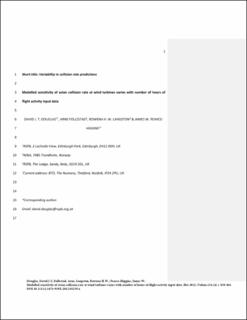| dc.contributor.author | Douglas, David J.T | |
| dc.contributor.author | Follestad, Arne | |
| dc.contributor.author | Langston, Rowena H.W. | |
| dc.contributor.author | Pearce-Higgins, James W. | |
| dc.date.accessioned | 2023-06-19T12:31:32Z | |
| dc.date.available | 2023-06-19T12:31:32Z | |
| dc.date.created | 2012-06-25T10:50:21Z | |
| dc.date.issued | 2012 | |
| dc.identifier.citation | Ibis. 2012, 154 (4), 858-861. | en_US |
| dc.identifier.issn | 0019-1019 | |
| dc.identifier.uri | https://hdl.handle.net/11250/3072074 | |
| dc.description.abstract | Collision risk modelling of birds at wind turbines typi-cally requires vantage point (VP) data to quantify birdflight activity. The number of VP observation hoursrequired to provide such data, and the associated error inpredicted collision rate, have not been formally assessed.Using the Band model and a randomization procedure,we examine the sensitivity of collision rate predictions forthe White-tailed EagleHaliaeetus albicillato varyinghours of input data on flight activity. Variability in colli-sion rate decreased with increasing number of observationhours. However, at the asymptote in variability (about 62observation hours) there was still considerable variabilityin predicted collision rate. VP watches are likely to beinherently variable, and collision rate predictions shouldassess the potential error associated with such results. | en_US |
| dc.language.iso | eng | en_US |
| dc.subject | avian flight activity | en_US |
| dc.subject | Band model | en_US |
| dc.subject | collision risk modelling | en_US |
| dc.subject | onshore wind | en_US |
| dc.subject | renewable energy | en_US |
| dc.subject | vantage point watches | en_US |
| dc.subject | wind farms | en_US |
| dc.title | Modelled sensitivity of avian collision rate at wind turbines varies with number of hours of flight activity input data | en_US |
| dc.type | Peer reviewed | en_US |
| dc.type | Journal article | en_US |
| dc.description.version | acceptedVersion | en_US |
| dc.subject.nsi | VDP::Matematikk og Naturvitenskap: 400::Zoologiske og botaniske fag: 480 | en_US |
| dc.subject.nsi | VDP::Teknologi: 500 | en_US |
| dc.source.pagenumber | 858-861 | en_US |
| dc.source.volume | 154 | en_US |
| dc.source.journal | Ibis | en_US |
| dc.source.issue | 4 | en_US |
| dc.identifier.doi | 10.1111/j.1474-919X.2012.01239.x | |
| dc.identifier.cristin | 931289 | |
| dc.relation.project | Norges forskningsråd: 193818 | en_US |
| cristin.unitcode | 7511,2,0,0 | |
| cristin.unitname | Avdeling for terrestrisk økologi | |
| cristin.ispublished | true | |
| cristin.fulltext | postprint | |
| cristin.qualitycode | 1 | |
